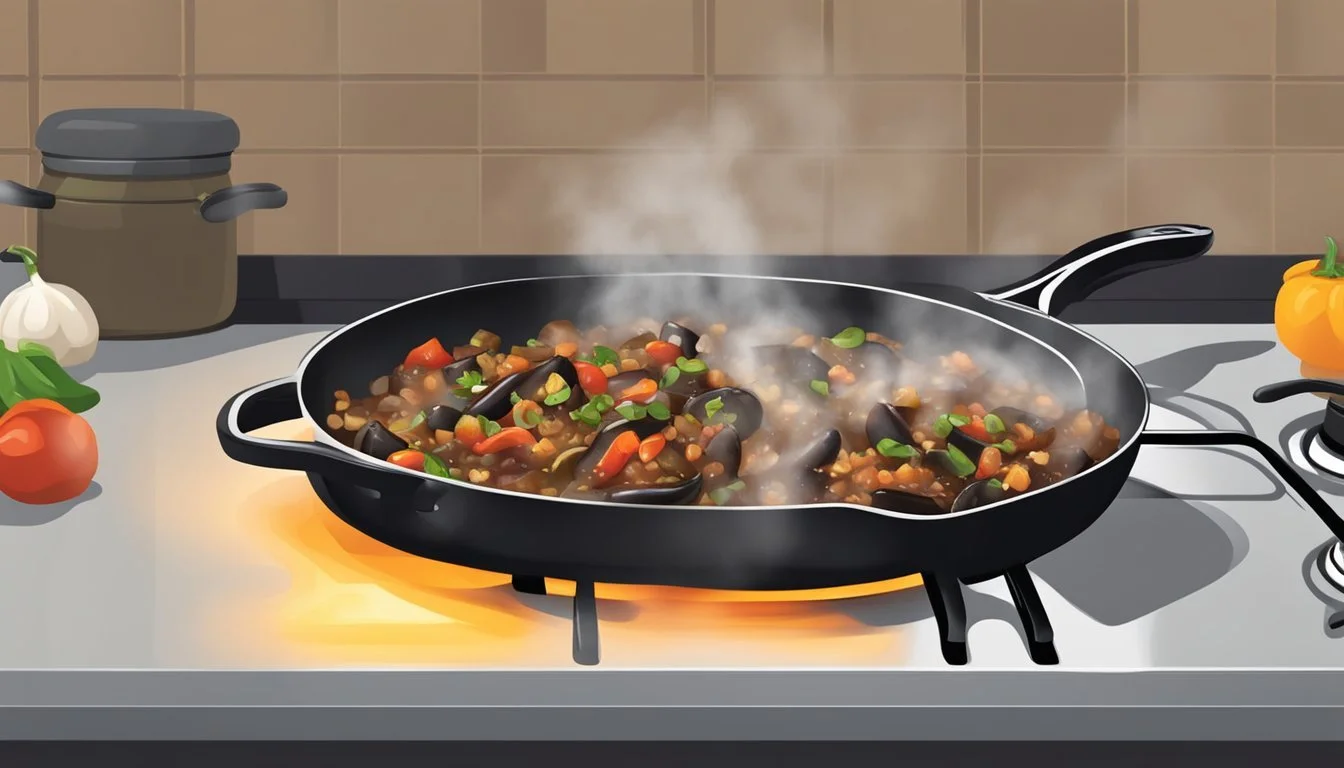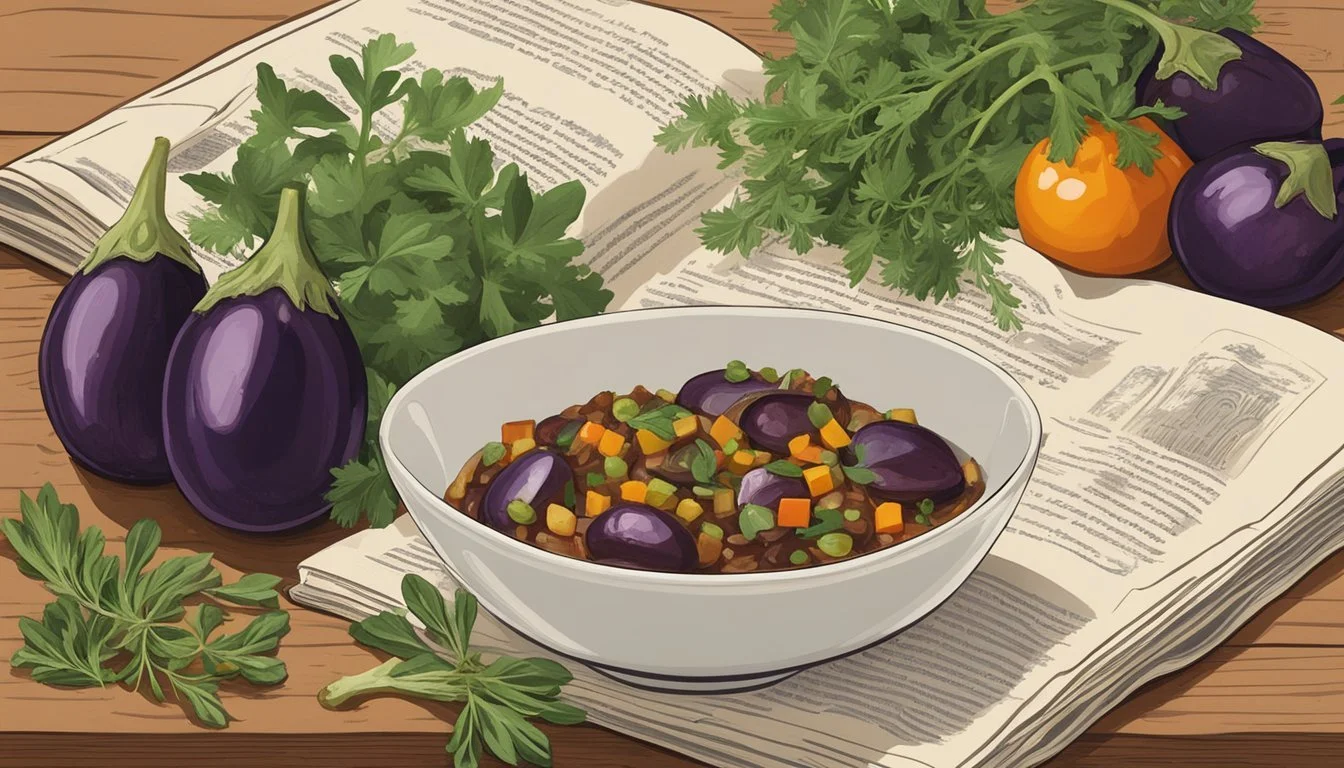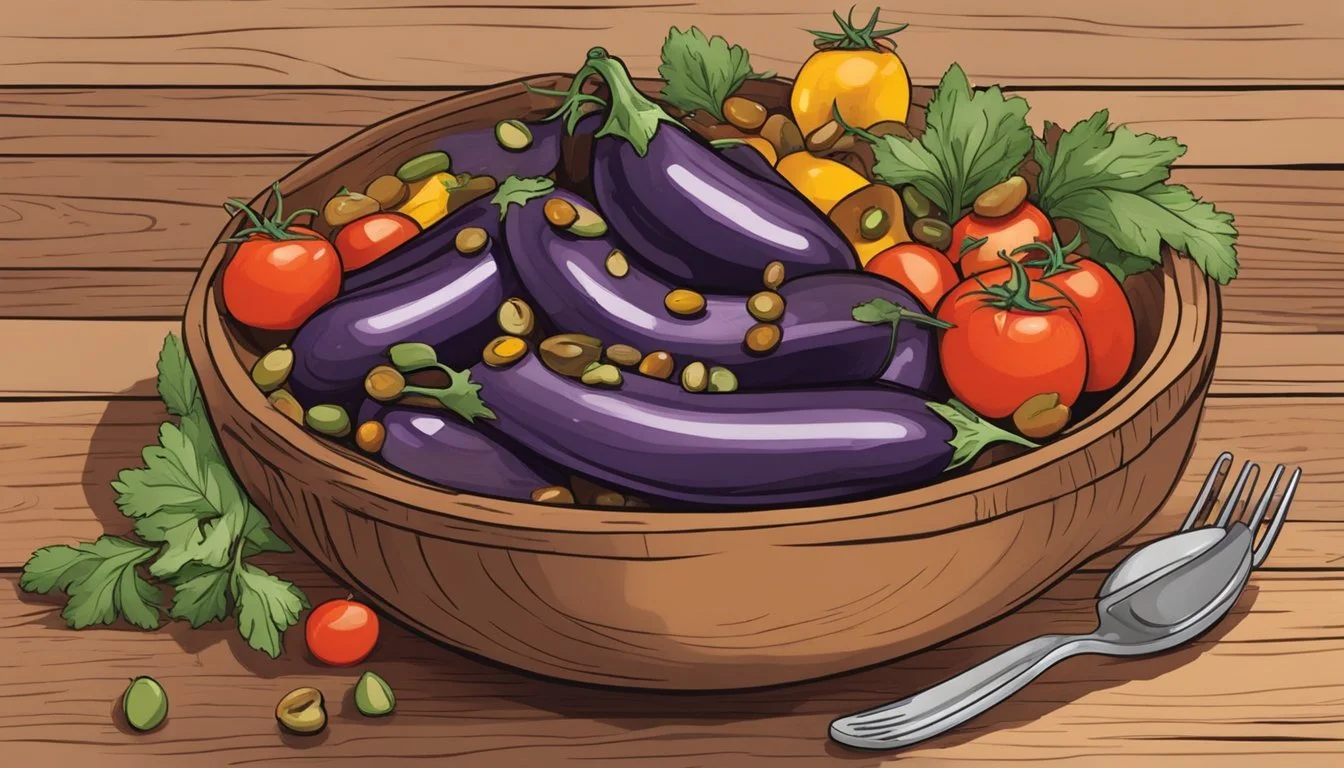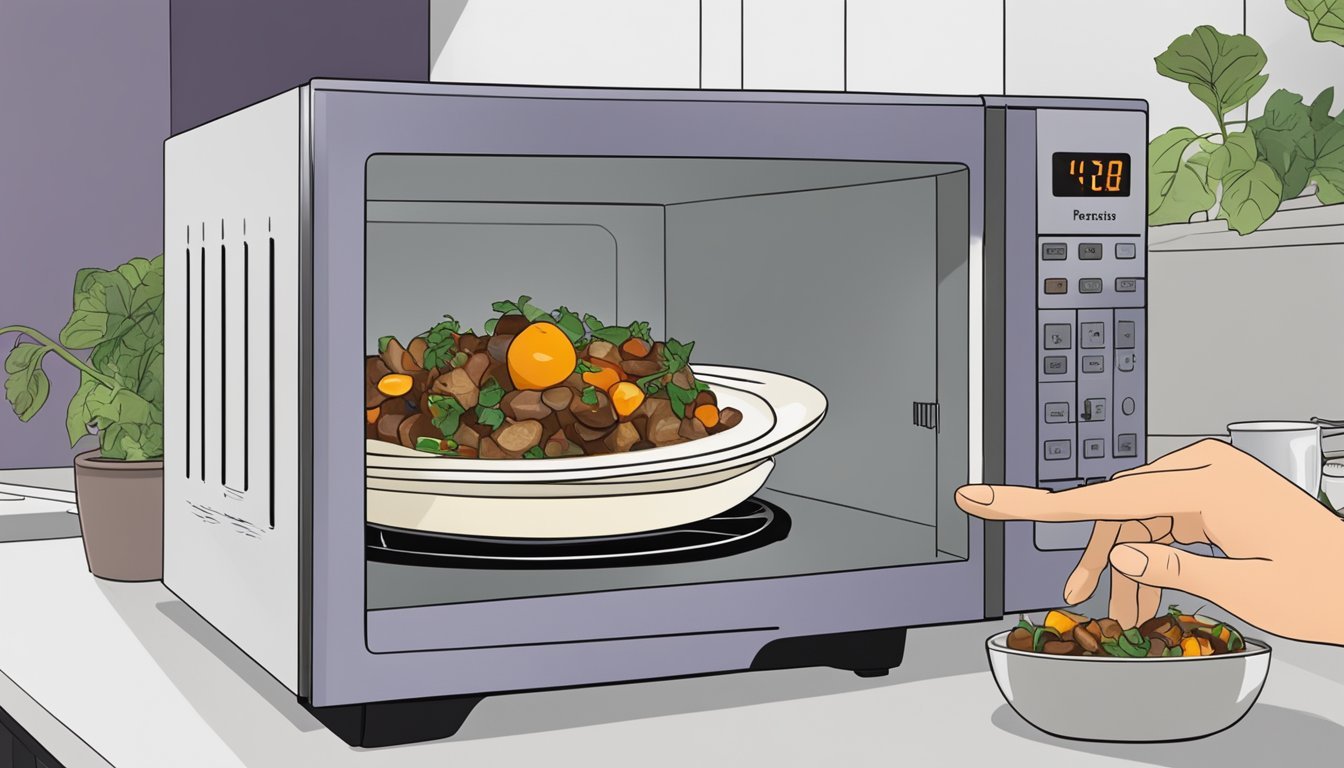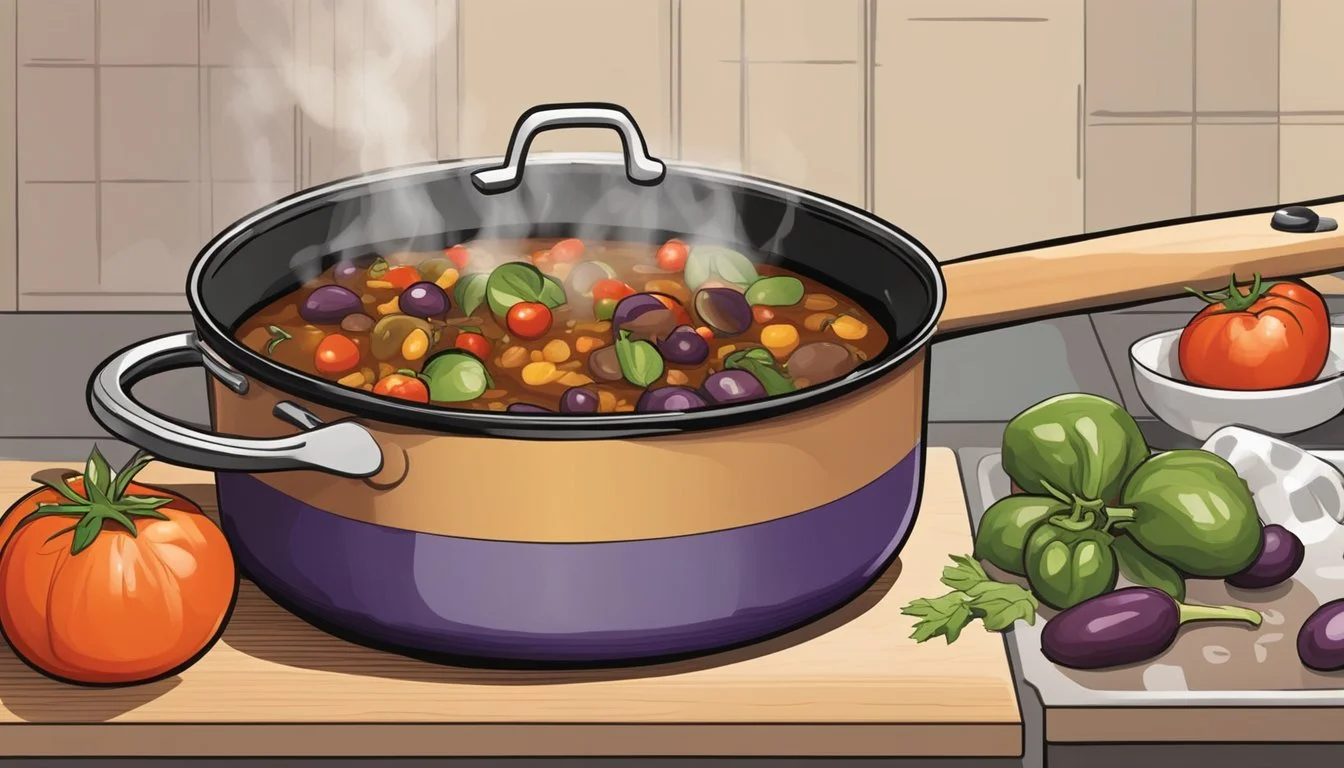How to Reheat Eggplant Caponata for Perfect Flavor and Texture
Reheating Eggplant Caponata to maintain its rich, Sicilian flavors can transform leftovers into a delectable meal. Whether enjoyed as an appetizer or a side dish, the key is in the method.
For optimal results, use the stovetop method to reheat your eggplant caponata, ensuring it retains its tender texture and complex taste. Simply warm a bit of olive oil in a skillet, add the caponata, and stir gently until heated through.
For those in a hurry, the microwave offers a quick alternative. Place the caponata in a microwave-safe dish, cover it with a lid or microwave-safe wrap, and heat in short intervals, stirring occasionally to distribute heat evenly. This approach ensures the traditional flavors stay vibrant and satisfying.
The Origin and Cultural Significance of Eggplant Caponata
Eggplant Caponata, known as caponata di melanzane in Italy, is a traditional Sicilian dish. This flavorful eggplant dish boasts a rich history rooted in Sicilian and Mediterranean cuisine.
Caponata is often served as an appetizer or side dish, typically enjoyed cold or at room temperature. It’s commonly paired with crusty bread, making it a versatile staple in Sicilian households.
The origins of eggplant caponata can be traced back to the island of Sicily, where the blending of various cultures has influenced local cuisine. The dish features eggplant, olive oil, tomatoes, onions, celery, capers, and olives.
This Sicilian caponata highlights the culinary tradition of using fresh, locally-sourced ingredients to create dishes with deep, complex flavors. The combination of sweet, sour, and savory elements is characteristic of many Sicilian recipes.
Eggplant Caponata is not just a dish; it represents the rich cultural tapestry of Sicily. Over time, it has become a beloved part of Mediterranean cuisine, celebrated for its hearty ingredients and bold taste.
In Sicilian culture, caponata is more than food—it's a culinary expression of the island’s history and the mingling of different influences over centuries. As such, it holds a special place in the hearts of those who enjoy Mediterranean dishes.
Understanding the Ingredients
Eggplant caponata is a vibrant Sicilian dish that balances sweet, sour, and savory flavors. Its ingredients include a variety of vegetables, herbs, and seasonings that each contribute to its unique taste and texture.
Essential Components of Eggplant Caponata
Eggplant is the star ingredient of caponata, known for its ability to absorb flavors while retaining a tender texture. Tomatoes add acidity and depth, often in the form of diced tomatoes or tomato paste.
Olives and capers bring a briny taste that enhances the complexity of the dish. Celery adds crunch, while onions provide sweetness when sautéed. Red bell peppers introduce a mild sweetness and vibrant color. Vinegar and a bit of sugar balance the flavors with a sweet and sour note.
Freshness and Selection of Vegetables
Selecting fresh vegetables is crucial for making delicious eggplant caponata. Choose eggplants that are firm and heavy for their size, with smooth, shiny skin. Fresh celery should be crisp with no signs of wilting.
Onions should feel heavy with no soft spots, and red bell peppers should be bright and firm. Tomatoes or tomato paste should be ripe but not overly soft. Using high-quality produce ensures the dish's flavors are bright and well-defined.
Herbs and Spices That Elevate the Dish
Fresh herbs like parsley and basil are often added towards the end of cooking for a fresh, aromatic finish. They should be vibrant green and fragrant when selected.
Pine nuts and raisins are sometimes included for additional texture and sweetness. Seasoning with salt and pepper is essential to enhance the dish's natural flavors. Utilizing a mix of olive oil, vinegar, and potentially a hint of sugar ties everything together, providing a signature balance of tastes that makes eggplant caponata so delightful.
Preparation Techniques
For a perfect eggplant caponata, it is essential to properly cook the eggplant and build a rich flavor base. Each step ensures that the dish maintains its traditional sweet and sour profile with a satisfying texture.
Properly Cooking Eggplant for Caponata
Cooking the eggplant right is crucial for an ideal caponata. Start by cutting the eggplant into 1-inch cubes and seasoning them generously with salt. This helps to draw out excess moisture and reduces bitterness.
The eggplant cubes are then roasted in a preheated oven at 400°F for about 25 to 30 minutes. They should be spread out on a baking sheet to ensure even browning. Roasting at a high temperature caramelizes the eggplant, adding depth to the dish.
Another method involves sautéing the cubes in olive oil. Use medium heat, turning the cubes frequently to prevent burning and to achieve a golden-brown color. This method allows for more control over the cooking process but requires careful attention to avoid scorching.
Building the Flavor Base
The flavor base of eggplant caponata is built by sautéing a combination of vegetables and adding a sweet and sour sauce. Begin by heating olive oil in a large skillet over medium heat. Add diced onions, bell peppers, and celery, seasoning with kosher salt and black pepper.
Cook the vegetables for about 5 to 7 minutes until they are soft. Stir frequently to ensure even cooking and to enhance the flavors.
Once the vegetables are softened, introduce additional ingredients like garlic, capers, and olives. These items deepen the complexity of the dish.
To achieve the classic sweet and sour taste, prepare a sauce using tomato paste, vinegar, and a touch of sugar. Add this sauce to the sautéed vegetables, stirring well to combine.
Simmer the mixture on low heat for about 10 minutes, allowing the flavors to meld together. The result is a rich, balanced, and flavorful base that complements the cooked eggplant perfectly.
Serving Suggestions
Eggplant caponata offers a versatile dining experience, making it suitable as an appetizer, side dish, or even a main course. Pair it with breads, serve it warm or cold, and enjoy its complex flavors in various settings.
Pairing with Breads and Crackers
Eggplant caponata pairs wonderfully with an assortment of breads and crackers. For a robust combination, serve it alongside crusty bread or crostini. These options provide a sturdy base that complements the soft, rich texture of the caponata.
Alternatively, opt for crackers or toasted pita for a lighter bite. This approach is ideal for parties and gatherings where finger foods are preferred. Artisanal breads with seeds and grains also enhance the flavor profile, adding a subtle crunch and nuttiness.
As a Side or Main Course
Caponata excels as both a side dish and a main course. When serving as a side, it pairs well with grilled meats, fish, and other Mediterranean dishes. Consider placing it alongside roasted chicken, grilled lamb, or baked fish to balance the meal.
As a main course, it can be served over polenta, paired with fresh pappardelle, or even combined with quinoa for a hearty vegetarian option. This versatility makes eggplant caponata an excellent choice for catering to diverse dietary preferences.
Serving Eggplant Caponata Cold or Warm
Eggplant caponata can be enjoyed either cold or warm, depending on personal preference and the occasion. When served cold, it acts as a refreshing appetizer or salad. This method is perfect for hot summer days, allowing the flavors to meld and intensify.
Warming the caponata brings out the depth and richness of its ingredients, making it a comforting dish for cooler weather. To reheat, warm it in a pan with a dash of water or microwave it for a quick option. Both methods ensure that the texture remains tender and the flavors vibrant.
Storage and Reheating
Proper storage and reheating methods are essential to maintain the rich flavors and textures of eggplant caponata. Follow these guidelines to ensure your dish remains delicious and enjoyable.
Proper Storage for Longevity
To keep eggplant caponata fresh, store it in an airtight container. Refrigeration is the most convenient method. Place the container in the refrigerator where it can last up to five days.
For longer storage, the freezer is an effective option. Portion the caponata into freezer-safe containers or heavy-duty freezer bags. Label them with the date to track freshness. When stored in the freezer, eggplant caponata can be preserved for three to four months.
Always cool the caponata to room temperature before placing it in the storage container. This prevents condensation, which could lead to a soggy texture. Avoid storing in metal containers to prevent any off-flavors from developing.
Best Practices for Reheating
Reheating eggplant caponata should be done gently to preserve its tender texture and bold flavors. The stovetop method is recommended. Transfer the portion you plan to eat to a small saucepan. Reheat over low to medium heat, stirring occasionally to ensure even warming. This method brings out the dish's rich taste without compromising the texture.
For convenience, the microwave is another option. Place the caponata in a microwave-safe container, cover it loosely to avoid splatters, and heat on medium power in short intervals, stirring between each. This approach helps maintain its integrity while ensuring thorough reheating.
Avoid reheating the entire batch if you plan to consume only a portion. Instead, serve and reheat only what you need to keep the remaining caponata fresh. These methods ensure the dish retains its delicious character, making it just as enjoyable as when it was first prepared.
Recipe Variations and Substitutions
There are numerous ways to adapt eggplant caponata to suit different tastes, dietary needs, and creative inclinations. From sticking to traditional recipes to incorporating modern twists, options abound.
Traditional vs. Modern Takes
Traditional eggplant caponata often includes ingredients like eggplant, celery, onions, capers, olives, and sometimes tomatoes, cooked together to create a rich, tangy relish. These ingredients are typically sautéed or sometimes fried to deepen their flavors. Classic recipes often boast a balance of sweet and sour notes, achieved with sugar and vinegar.
Modern versions, on the other hand, may choose to bake or roast the eggplant instead of frying, as seen in many contemporary recipes. This method can reduce the dish's oil content, catering to healthier preferences while preserving its essence.
Substituting Ingredients for Dietary Needs
For those needing to accommodate specific dietary requirements, several substitutions can be made while preserving the dish’s integrity. Gluten-free needs can easily be met since traditional caponata is naturally free from gluten-containing ingredients. However, checking all labels for hidden gluten is advised.
To make the recipe vegan, ensure no animal products are used—though traditional caponata is typically vegan already. For a low-sodium version, reduce the amount of added salt and opt for low-sodium alternatives when it comes to ingredients like capers and olives.
Creative Twists on the Classic
Creative cooks can experiment with various additions and modifications to the classic recipe. Adding sweet bell peppers can introduce a colorful and flavorful twist. Some may incorporate pine nuts to add a nutty richness and golden raisins for a touch of sweetness.
For an even more adventurous variation, consider adding cooked chickpeas for protein or swapping eggplant with zucchini or summer squash, altering the texture but keeping the core flavors intact. Each of these adaptations can give the dish a new character while still paying homage to its roots.
Tips and Tricks for Perfect Caponata
For the best flavors, prepare caponata a day ahead. This allows the ingredients to meld, enhancing both taste and consistency.
To reheat, opt for gentle methods like stovetop heating. Microwave reheating can cause uneven warming and loss of texture.
Maintain the rich flavors by reheating on a low to medium heat. Stir frequently to prevent sticking or burning.
Adjust the taste by incorporating a splash of extra virgin olive oil or a pinch of fresh herbs, such as basil or parsley, during reheating.
Keep an eye on the moisture level. If the caponata appears too dry, add a bit of water or vegetable broth while reheating.
For added freshness, consider adding a few fresh ingredients like diced tomatoes or a spoon of capers after reheating.
Store any leftovers in an airtight container in the refrigerator to preserve the flavors.
Utilize a colander to remove excess oil from the eggplant before cooking to achieve a better texture.
By following these tips, your reheated caponata will be as delightful and flavorful as when first prepared.

